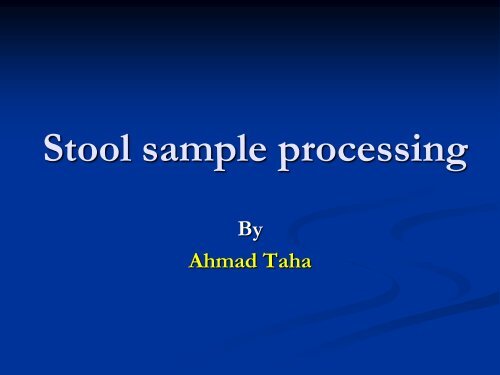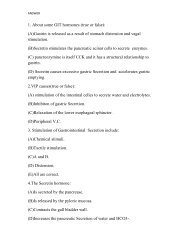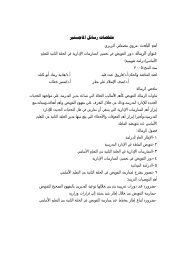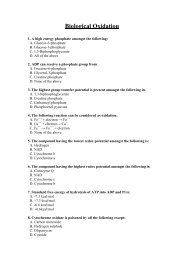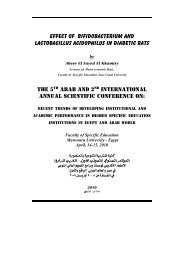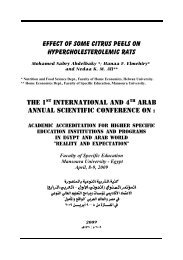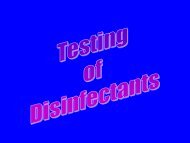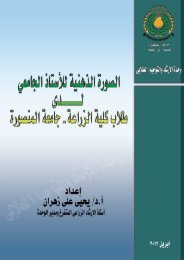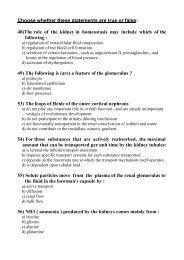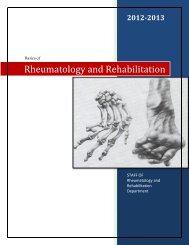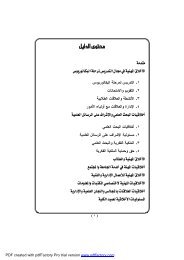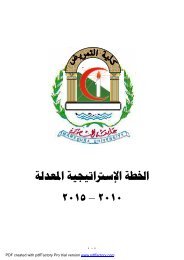Stool sample processing
Stool sample processing
Stool sample processing
Create successful ePaper yourself
Turn your PDF publications into a flip-book with our unique Google optimized e-Paper software.
<strong>Stool</strong> <strong>sample</strong> <strong>processing</strong><br />
By<br />
Ahmad Taha
The specimen of choice<br />
The specimen of choice is diarrhea stool(fresh<br />
random) in fecal transport system<br />
A rectal swab is only recommended for infants<br />
Visible pus, mucus, or blood should be included in<br />
<strong>sample</strong> specimens.<br />
A single stool specimen cannot be used to rule<br />
out bacteria as a cause of diarrhea. More than<br />
two specimens should only be submitted from<br />
patients for whom there is a high degree of<br />
suspicion.
Pre specimen <strong>processing</strong><br />
Patient preparing<br />
Instruct the patient on how the specimen<br />
should be collected and transferred to the<br />
container; provide him/her with sticks or<br />
plastic spoon and containers.
How to collect the <strong>sample</strong><br />
Faecal material is placed into sterile<br />
container with the aid of the plastic spoon
Quantity of specimen<br />
The specimen should contain at least 5 g of faeces
Labelling the speciemen<br />
Label the specimen with patient<br />
information (Name, age, department and<br />
diagnosis at admission )<br />
Very importantly give a good history on<br />
the request form:<br />
1. symptoms of gastroenteritis as bloody stool,<br />
vomiting, fever, abdominal pain and<br />
dehydration.
2. Food habits (drinking raw/unpasteruized<br />
milk, eating undercooked meat)<br />
3. Exposure to farm environment<br />
4. Medical disease as hepatitis, colitis,<br />
protozoal infection, and renal impairment.<br />
5. Any medical therapy especially<br />
antimicrobial therapy
Transport<br />
Time relapse before <strong>processing</strong> the <strong>sample</strong><br />
<strong>Stool</strong> <strong>sample</strong>s should be examined and cultured<br />
as soon as possible after collection. As the stool<br />
specimen cools, the drop in pH will inhibit the<br />
growth of most Shigella spp. and some<br />
Salmonella spp.<br />
In case of delay longer than 1 hour in<br />
transportation of specimens to the laboratory,<br />
part of specimen will be transferred to cotton<br />
swab and inserted into a container of Cary-Blair<br />
transport medium
Criteria of specimen rejection<br />
specimen contaminated with urine.<br />
residual soap, or disinfectants.<br />
Specimens received in grossly leaking transport<br />
containers;<br />
dry specimens<br />
specimens submitted in fixative or additives;
Processing of fecal <strong>sample</strong><br />
The color and consistency of <strong>sample</strong>s<br />
described, whether they were semisolid or<br />
fluid and whether it contained blood, mucus<br />
and pus.<br />
Direct microscopic examination of a<br />
fecal <strong>sample</strong> in physiologic saline
When to order stool culture ?<br />
According to the Centers for Disease Control and Prevention<br />
(CDC), doctors are most likely to order a stool culture for<br />
patients with any of the following characteristics:<br />
Bloody diarrhea<br />
High Fever<br />
Tenesmus (is the constant feeling of the need to empty the<br />
bowel,with passage of blood & mucus accompanied by pain, and<br />
cramping)<br />
Severe or persistent symptoms >3 days<br />
Recent travel to a third world country<br />
Known exposure to a bacterial agent<br />
Presence of fecal leukocytes<br />
Sever dehydration
Results<br />
Some bacteria that are normal inhabitants of the<br />
digestive tract are known as the enteric bacteria.<br />
Escherichia coli, Klebsiella, Enterobacter,<br />
and Pseudomonas are members of this<br />
group.<br />
When only normal flora are found the results are<br />
reported as "no enteric pathogens found."
True gastrointestinal pathogens<br />
The following bacteria are not normal<br />
inhabitants of the digestive tract, and are<br />
known to cause gastrointestinal infection:<br />
Campylobacter<br />
Shigella<br />
Salmonella<br />
Yersinia<br />
Enterohemorragic E. coli<br />
Vibrio<br />
Aeromonas
Result<br />
If bacteria are not the cause of an intestinal<br />
infection, a fungal or viral culture might be<br />
necessary.
Result<br />
Patients with AIDS, or other immune system<br />
diseases, sometimes have gastrointestinal<br />
infections caused by fungal organisms such as<br />
Candida, or by viral organisms including<br />
Cytomegalovirus (CMV).<br />
Candida can also become an opportunistic<br />
intestinal pathogen when antibiotics or radiation<br />
have destroyed the normal stool flora.
Result<br />
Several intestinal parasites, such as Giardia<br />
lamblia, also cause gastrointestinal infection and<br />
diarrhea.<br />
Parasites are not cultured, but are identified by<br />
Direct microscopic examination of a<br />
fecal <strong>sample</strong> in physiologic saline<br />
and parasites test.
SO Routine stool culture is used to<br />
Campylobacter<br />
detect<br />
Enterohemorrhagic E. coli (O157:H7)<br />
Shigella<br />
Salmonella.<br />
Less frequently isolated bacterial causes of<br />
diarrhea are Vibrio spp., Yersinia<br />
enterocolitica, and Aeromonas spp.
Culture the specimens
Routine culture for Salmonella &<br />
Media<br />
Selenite-F broth or tetrathionate.<br />
SSA, XLD and HEA.<br />
Reagents<br />
API 20 E Kit.<br />
Shigella<br />
Salmonella and Shigella antiserum<br />
(polyvalent and monovalent).
Selenite-F broth<br />
Selenite Broth (Selenite-F Broth) is<br />
used as an enrichment medium for the<br />
isolation of Salmonella from feces, urine,<br />
water, foods and other materials of sanitary<br />
importance.<br />
Sodium selenite inhibits the growth of<br />
gram-positive and many gram-negative<br />
bacteria including enterococci and<br />
coliforms, whereas the salmonellae are not<br />
affected.
Sodium selenite is highly toxic at near-neutral pH.<br />
Buffer salts are present to help maintain the pH which<br />
may rise as the toxicity decreases . A rise in pH decreases<br />
selective activity of Selenite.<br />
A fermentable carbohydrate ( lactose) is also present to<br />
provide acid to neutralise the alkali produced when the<br />
selenite is reduced by bacteria.<br />
The function of the phosphate is two-fold; it serves to<br />
maintain a stable pH and lessens the toxicity of the<br />
selenite, thus increasing the capacity of the medium.
Tetrathionate Broth<br />
Tetrathionate Broth base, with added<br />
iodine-iodide solution, is used as a<br />
selective enrichment medium for the isolation<br />
of Salmonella from feces, urine, foods and<br />
other materials of sanitary importance.
Routine culture for<br />
Enterohemorragic E. coli
Interpretation<br />
a) Positive result<br />
- Agglutination of the Test latex occurs<br />
within 1 minute.<br />
- No agglutination of the Control latex.<br />
Perform biochemical tests to confirm that the<br />
organism is an E. coli strain.<br />
b) Negative result<br />
- no agglutination of the Test latex.<br />
c) Non-interpretable result<br />
- clumping of the Control latex.
Media<br />
Vibrio spp.<br />
Alkaline peptone water<br />
TCBS (Thiosulfate Citrate Bile salt Sucrose<br />
Agar)
Selective Media Commonly Used to Recover Enteropathogen<br />
CULTURE MEDIA<br />
Mac Conkey agar<br />
Hektoen enteric agar<br />
(HE)<br />
Xylose-lysine deoxy<br />
cholate (XLD)<br />
Campylobacter blood<br />
agar (CAMPY-BA)<br />
Purpose<br />
To recover Enterobacteriaceae<br />
and other fastidious Gram<br />
negative organisms<br />
A highly selective media to<br />
recover salmonella, shigella,<br />
contain indicator to detect<br />
H2S production<br />
A differntial media for<br />
isolation of shigella and<br />
salmonella from stool<br />
Selective media to isolate<br />
campylobacter from stool<br />
Pathogens<br />
Salmonella, shigella<br />
(NLF)<br />
Salmonella :blue green<br />
with black centre<br />
Shigella green without<br />
black centre<br />
Salmonella: red with black<br />
centre<br />
Shigella: red or clear<br />
Appears pink grey moist<br />
when incubated at 42°C
Selective media commonly used to recover<br />
diarrheal agents<br />
CULTURE<br />
MEDIA<br />
Thiosulphate<br />
bile salt<br />
sucrose agar<br />
(TCBS)<br />
Cycloserine<br />
cefoxitin<br />
fructose agar<br />
(CCFA)<br />
Sorbitol<br />
macconkey<br />
agar (SMAC)<br />
Purpose<br />
Vibrio species<br />
Aeromonas species<br />
selective media for<br />
clostridium difficle<br />
A differntial media to<br />
detect sorbitol<br />
negative E.coli<br />
(contain sorbitol<br />
instead of lactose)<br />
Pathogens<br />
Yellow colonies; sucrose fementing vibrio sp.<br />
Such as V. cholera<br />
Blue green colonies: non sucrose fermenters<br />
as V. vulnificus, parahaemolyticus<br />
Appeasrs yellow from fructose fermentation<br />
E.coli O157: H7 apear colorless
E.Coli O157:H7 on Sorbitol MacConkeys’ agar (SMAC)
Campylobacter colonies on campy<br />
blood agar
Salmonella colonies on Hektoen enteric agar
Salmonella colonies on XLD


